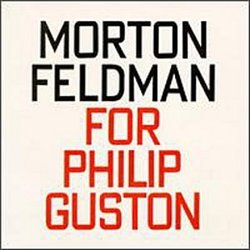Hypnotic Sound Canvas
Christopher Forbes | Brooklyn,, NY | 12/31/2003
(5 out of 5 stars)
"The relationship between Feldman and Philip Guston was perhaps the strongest mutual influence in the New York School of Painters and Musicians. Feldman was friends with all the New York School Painters, but with Guston there was a deep aesthetic bond. Guston's love affair with color in his Abstract Expressionist period is similar to Feldman's love of sheer sound...interestingly, both men were criticized for creating works that were "too beautiful" in a time when beauty had become suspect in Art. But later in life, the two men became estranged. Guston returned to figuration in his late, ominous cartoon-like works, and Feldman never quite forgave the betrayal of the Abstract Expressionist ideals by his friend. Though they never officially broke the friendship, the close bonds they had once had cooled. But when Guston died in 1980, the floodgates poured out for Feldman. For Philip Guston, completed in 1984, was one of a series of late works that were tributes to Feldman's friends, both living and dead. For Philip Guston is one of the longest of these works, clocking in at around four hours, depending on tempo chosen. By the time of these late works, Feldman was more interested in "scale" than in form, and For Philip Guston is one of his longest works, topped only by the Second String Quartet. It is scored for one of Feldman's most common instrumental groupings, flute (doubling alto flute) percussion (mostly mallet percussion) and piano (doubling Celeste). The work unfolds in an almost timeless manner. Beginning with a haunting "theme" of four notes, the three instruments circle around each other, floating in and out of tonality, at barely a whisper for the full four hours. Feldman's ear for complex harmony and the unique sounds of his instruments is astounding. And his balance between sound and silence is almost hypnotic.The ensemble on this disc has an incredible pedigree in this music. Both Blum and Williams played regularly with Feldman as a trio and the work was written for them. There is never a sense of hurry, nor of the incredible concentration that is required to interpret the rhythmic complexities of this work. All three players show a great sense of tonal balance and control, essential for this music, and Vigeland coaxes warmth out of the piano that approaches the unique sound of Feldman himself on piano. The other competing set for this work, The California EAR Unit on New Albion, is also an excellent performance, but to my ear, this Hat Hut recording has the edge, both in performance and in sonics."


 Track Listings (4) - Disc #1
Track Listings (4) - Disc #1